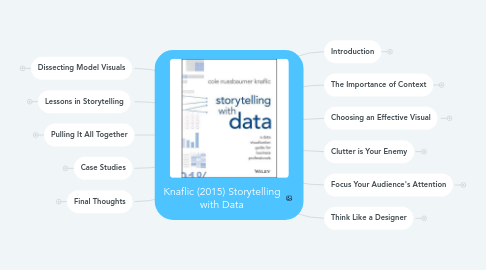Knaflic (2015) Storytelling with Data
by Ivan Lanin


1. Dissecting Model Visuals
1.1. Line graph
1.2. Annotated line graph with forecast
1.3. 100% stacked bars
1.4. Leveraging positive and negative stacked bars
1.5. Horizontal stacked bars
2. Lessons in Storytelling
2.1. The magic of story
2.2. Storytelling in plays
2.3. Storytelling and the cinema
2.4. Storytelling and the written word
2.5. Constructing the story
2.6. The narrative structure
2.7. The power of repetition
2.8. Tactics to help ensure that your story is clear
2.8.1. Horizontal logic
2.8.2. Vertical logic
2.8.3. Reverse storyboarding
2.8.4. Fresh perspective
3. Pulling It All Together
3.1. Understand the context
3.2. Choose an appropriate display
3.3. Eliminate clutter
3.4. Draw attention where you want it
3.5. Think like a designer
3.6. Tell a story
4. Case Studies
4.1. Color considerations with a dark background
4.2. Leveraging animation in the visuals you present
4.3. Logic in order
4.4. Strategies for avoiding the spaghetti graph
4.5. Alternatives to pies
5. Final Thoughts
5.1. Where to go from here
5.2. Tips
5.2.1. Learn your tools well
5.2.2. Iterate and seek feedback
5.2.3. Devote time to storytelling with data
5.2.4. Seek inspiration through good examples
5.2.5. Have fun and find your style
5.3. Building storytelling with data competency
6. Introduction
6.1. Bad graphs are everywhere
6.2. We aren't naturally good at storytelling with data
6.3. Who this book is writter for
6.4. How I learned to tell stories with data
6.5. How you'll learn to tell stories with data: 6 lessons
6.6. Illustrative exaamples span many industries
6.7. Lessons are not tool specific
6.8. How this book is organized
7. The Importance of Context
7.1. Exploratory vs. explanatory analysis
7.2. Who, what, and how
7.3. Consulting for context: question to ask
7.4. The 3 minutes story & big idea
7.5. Storyboarding
8. Choosing an Effective Visual
8.1. Simple text
8.2. Tables
8.3. Heatmap
8.4. Graphs
8.4.1. Points
8.4.2. Lines
8.4.3. Bars
8.4.4. Area
8.4.5. Other types
8.5. To be avoided
8.5.1. Pie charts
8.5.2. 3D
8.5.3. Secondary y-axis
9. Clutter is Your Enemy
9.1. Cognitive load
9.2. Clutter
9.3. Gestalt principles of visual perception
9.3.1. Proximity
9.3.2. Similiarity
9.3.3. Enclosure
9.3.4. Closure
9.3.5. Continuity
9.3.6. Connection
9.4. Lack of visual order
9.4.1. Alignment
9.4.2. White space
9.5. Nonstrategic use of contrast
9.6. Decluttering
10. Focus Your Audience's Attention
10.1. You see with your brain
10.2. A brief lesson on memory
10.2.1. Iconic memory
10.2.2. Short-term memory
10.2.3. Long-term memory
10.3. Preattentive attributes signal where to look
10.4. Preattentive attributes in text
10.5. Preattentive attributes in graphics
10.6. Strategic preattentive attributes
10.6.1. Size
10.6.2. Color
10.6.3. Position
